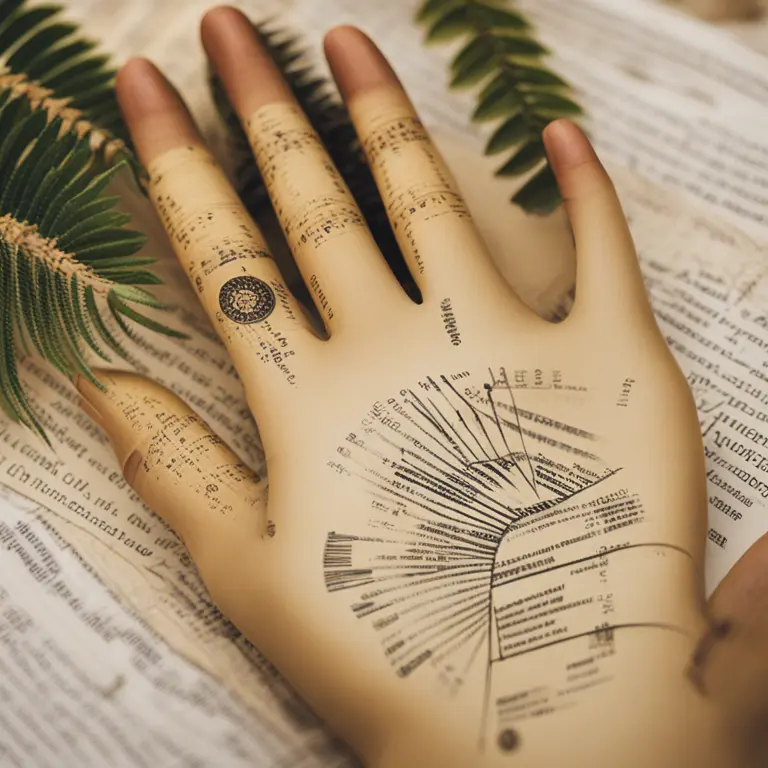
Palmistry: A Science-Based Inquiry
Examining the intersection of palmistry and empirical science, this article explores what research reveals about the ancient practice of hand reading.
article by Nora Pennington
The Quest for Scientific Validation
In an age where empirical evidence reigns, the practice of palmistry stands at a junction between mysticism and verifiable knowledge. Once considered an art steeped in tradition, palmistry — or chiromancy — involves reading one's palms to predict their future or understand their personality traits. However, this approach has often been met with skepticism in the scientific community. This article delves into the ongoing quest to find a scientific grounding for palmistry, highlighting both the challenges and the curious interest that modern research has brought to the fore.

Palmistry under the Research Lens
Recent inquiries into dermatoglyphics, the study of the unique patterns of ridges on the fingers and the palms, have shed light on the genetic and environmental factors that contribute to these patterns. Nonetheless, a direct correlation between these patterns and one's destiny or personality remains elusive and scientifically unsubstantiated. This has painted palmistry more as a pseudoscience — a field with claims and beliefs that are not based on scientific methods.
Psychology's Take on Palmistry
Psychologists have explored palmistry from the angle of a cold reading technique. Cold reading is a set of strategies used to convince people of an ability to know more about them than a reader actually does. This psychological viewpoint suggests that palmistry operates on a similar level, using high-probability guesses and interpreting non-verbal cues to draw inferences. As such, the 'accuracy' of palm reading may lie more in the skill of the reader than in the lines of the hand.
Statistical Analysis and Patterns
Attempts have been made to employ statistical analysis in the field of palmistry, with researchers looking for patterns across large datasets. But this approach has often culminated in inconclusive results. There remains a lack of empirical evidence to support any consistent links between hand features and specific outcomes in life, personality traits, or compatibility between individuals, as traditional palmists might claim.
Neuroscientific Perspectives on Palm Lines
Neuroscientists have been exploring the brain's influence on the development of the body, including palm lines. Some suggest that significant experiences or changes could theoretically be reflected in physiological growth patterns. Yet, no concrete evidence has shown that life events or character attributes can be decoded from the lines or shapes observed in one's palms.
Palmistry and Personal Belief
Despite the skepticism from scientific circles, palmistry persists in many cultures as a valued tradition. For adherents, the benefits of palm readings may arise from the personal meaning and psychological comfort they provide, regardless of measurable scientific outcomes. This speaks to the broader human search for guidance and personal insight, a domain where hard data may not always be the primary determinant of value.
Future Research and Potential Discoveries
While the current scientific consensus largely relegates palmistry outside the bounds of empirical science, the future holds an unknown potential for discoveries that could change this perception. Advancements in genetics, psychology, and neurology could possibly provide new frameworks to understand the development of palm lines and their significance. For now, though, palmistry remains an art form rich in history, yet to be embraced by the mantle of science.
Published: 2/1/2024
Modified: 2/1/2024
More predictions
Come back here soon to learn more about yourself and your future


An Introduction to Palmistry: Insights from Your Hands
Discover the art of palm reading and how the lines and shapes of your hands can reveal personal insights and future possibilities.


The Essence of Palmistry: Journey Through Hand Analysis
Grasp the basics of palmistry and learn how to interpret the lines and shapes in your hands for insights into personality and destiny.


The Palm's Path to Prosperity: Interpreting the Success Line
Uncover the mysteries of the palmistry success line and learn how it may influence your journey towards achieving your goals and aspirations.